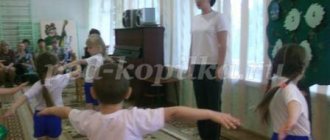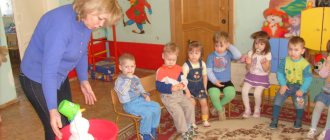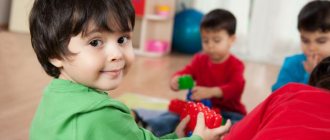From the author
The successful implementation of program objectives depends on a number of factors and, above all, on the way of life of a preschool institution, the atmosphere in which the child is raised, and on a specially designed, thoughtful developmental environment.
The effectiveness of education and training is achieved through the painstaking work of teachers who work directly with children and all preschool employees who communicate with preschoolers during the day.
The system of work on teaching children their native language, introducing them to fiction is presented in the works of V. V. Gerbova “Development of speech in kindergarten”, “Introducing children to fiction” (M.: Mozaika-Sintez, 2005).
The manual “Classes on speech development in the second junior group of kindergarten”, written within the framework of the “Program of education and training in kindergarten” edited by M. A. Vasilyeva, V. V. Gerbova, T. S. Komarova, supplements recommendations on the most important direction of pedagogical activity - purposeful and systematic training of preschoolers in the classroom. The practical purpose of the book is to provide educators with approximate guidelines for planning lessons (defining topics and learning goals, ways to implement them).
Project for speech development in the second junior group “The Tale of a Merry Tongue.”
Once upon a time there lived a Cheerful Tongue in his house. One day he decided to take a walk. He looked out of the house and froze, became thin, sharp, like a needle. He hid in the house and looked out again, and again, like a snake’s tongue. Then I finally decided to go out and take a walk. He went to the clearing and didn’t even walk, but rolled like a reel. In the clearing he saw a fungus. I saw a horse and rode it. He also met an important turkey. Suddenly he heard the steamer hum and realized that it was already a long time, it was time to go home. I looked at my watch and it was definitely time. And at home the sponges punished him for walking for so long. I brushed Tongue's teeth and went to bed in my warm bed.
The Tale of the Merry Tongue No. 2
Once upon a time there lived a Merry Tongue. So one day he decided to go for a walk to the children's park. I looked out of the house - it was warm and sunny. He decided to bask in the sun, like a pancake in a frying pan. I warmed myself up and hit the road. Tongue came to the park and decided to ride the slide first, then on the swing. I clicked the tip with pleasure and went to watch magic tricks. And then Tongue enjoyed the delicious jam, which was in a beautiful ladle, and ate some candy. I looked at my watch - it was already late. And he rolled home like a reel. And at home the sponges punished him for walking for so long. I brushed Tongue's teeth and went to bed in my warm bed.
The Tale of the Merry Tongue No. 3
Once upon a time there lived a Merry Tongue. And he had a house - his mouth. And the house had 2 doors - lips and teeth. Tongue decided to put things in order in his house. First I whitewashed the ceiling. Then the walls, like a real painter. The house sparkled like new. The tip of the tongue clicked with pleasure. He sat down on the porch and played the pipe, the harmonica and the drum. I also gave myself a festive dinner - pancakes with delicious jam. Then he looked at his watch - it was late. It's time to rest. He brushed his teeth and went to bed in his bed.
"Kolobok"
Kolobok-Kolobok
You are a ruddy little side,
You roll along the path,
Beware of forest animals.
In a low box, make a model of a forest with a path and animals (hare, wolf, bear, fox). The child must help the kolobok (tennis ball) ride along this path and avoid meeting the forest inhabitants.
"Peas"
There's something hidden at the bottom
But I can't see it yet.
I'll blow on the peas
And I’ll say what’s there, friends.
Glue a picture to the bottom of a shallow plate (lid) and add peas. The child’s task is to inflate the peas from the middle and see the picture.
"Airplanes"
I built the plane
I invite you to play.
Whose will fly farthest?
That pilot will win.
Place the finished paper airplanes on the table to start. Each pilot blows on his own plane. Whoever has the best engine and whose plane flies farthest wins.
Features of speech development in children of the fourth year of life
In the fourth year of life, special attention is paid to developing the need to speak out independently.
Kids speak to communicate, explain, ask for something, and also accompany play actions with speech. One third of their messages and explanations consist of complex sentences, which allows them to improve the syntactic side of children’s speech.
By the age of three, the ability to analyze speech appears. A child, although he himself does not know how to pronounce words correctly, catches when someone else pronounces them incorrectly. Children can distinguish similar sounding words (Sashulka - icicle). However, it is too early to talk about speech perfection of hearing (coherent speech is more difficult to perceive by ear than individual words).
At this age, children begin to hear and reproduce some intonations (joyful, edifying, interrogative).
Although the fourth year is a period of intensive assimilation of sounds, along with their correct pronunciation, omission, replacement, assimilation and softening of sounds are observed in children’s speech (the pronunciation of soft sounds is easier for the child than hard ones).
The correct pronunciation of sounds in a child is easily disrupted due to fatigue, illness, or communication with small children who speak poorly.
Pronunciation defects make it difficult to master the grammatical structure of speech and prevent the child from communicating with peers, since his statements are difficult to understand by others.
In children 3–4 years old, breathing is intermittent, and the rate of speech is accelerated (less often, slow), so it can be difficult to listen to them. In this regard, the content of work on developing the sound culture of speech includes exercises to improve breathing, strength, and pitch of the voice.
The problem of forming a dictionary also has many aspects. It is known that in the third year of life, children easily recognize individual objects (vegetables, furniture, dishes, etc.), but do not always name them correctly. By the age of three, children perceive objects, trying to characterize their signs, qualities, and actions with them.
Understanding some of an adult's questions regarding familiar objects can cause difficulties for children, in particular when the object acts as an object of action. Children, looking at the picture, accurately answer the question “Who (what) is this?” (girl, doll, pants, needle, thread), but to the question “Who does the girl sew pants for?” some of them answer “The bear is sewing” (just recently the teacher was sewing up the little bear’s pants).
In the dictionary of children of the fourth year of life, significant quantitative fluctuations are recorded, which are explained by the individual characteristics of the development of children.
Unfortunately, researchers still rely on E. Arkin’s data on the composition of vocabulary in children of the fourth year of life, published in 1968. (It is possible that a modern child has different quantitative characteristics.) So, according to E. Arkin, in a child’s dictionary: nouns and pronouns make up 50.2%, verbs – 27.7%, adverbs – 5%, adjectives – 11.8% [ 1] .
Children quite successfully master the so-called everyday vocabulary, which helps them communicate. In addition, it is necessary to help children learn words denoting parts and details of objects, their qualities. Some generic concepts should be introduced into the dictionary, otherwise children group objects based on random rather than essential features.
At this age, children intensively master prepositions, conjunctions, and question words (the basis for improving syntax).
Vocabulary work is closely related to work on improving the grammatical structure of speech (word formation, inflection, etc.).
Children distinguish words based on the prefix, suffix (came - left - came, cup - cup). Kids master the agreement of singular past tense verbs with nouns, the correct forms of the genitive and accusative plural cases of nouns (boots, mittens, foxes), possessive adjectives (hare, fox); begin to use adjectives and adverbs in the comparative degree.
It is known that the development of the grammatical structure of speech occurs especially quickly in the second half of the third year of life. (According to researchers, up to three and a half years, and according to some indicators, up to four years, speech does not change significantly.)
In the fourth year of life, the number of simple common sentences gradually increases, and complex sentences appear.
At this age, children ask questions that are not related to their direct experience. (“This is a rabbit. What’s his last name?” “At night the sun turns into the moon?” “What kind of relative are you?” (Addresses the teacher.))
In the second half of the year, the number of questions aimed at clarifying cause-and-effect relationships increases.
Valentina Viktorovna Gerbova
Classes on speech development in the second junior group of kindergarten. Lesson Plans
From the author
The successful implementation of program objectives depends on a number of factors and, above all, on the way of life of a preschool institution, the atmosphere in which the child is raised, and on a specially designed, thoughtful developmental environment.
The effectiveness of education and training is achieved through the painstaking work of teachers who work directly with children and all preschool employees who communicate with preschoolers during the day.
The system of work on teaching children their native language, introducing them to fiction is presented in the works of V. V. Gerbova “Development of speech in kindergarten”, “Introducing children to fiction” (M.: Mozaika-Sintez, 2005).
The manual “Classes on speech development in the second junior group of kindergarten”, written within the framework of the “Program of education and training in kindergarten” edited by M. A. Vasilyeva, V. V. Gerbova, T. S. Komarova, supplements recommendations on the most important direction of pedagogical activity - purposeful and systematic training of preschoolers in the classroom. The practical purpose of the book is to provide educators with approximate guidelines for planning lessons (defining topics and learning goals, ways to implement them).
Features of speech development in children of the fourth year of life
In the fourth year of life, special attention is paid to developing the need to speak out independently
.
Kids speak to communicate, explain, ask for something, and also accompany play actions with speech. One third of their messages and explanations consist of complex sentences, which allows them to improve the syntactic side of children’s speech.
By the age of three, the ability to analyze speech
.
A child, although he himself does not know how to pronounce words correctly, catches when someone else pronounces them incorrectly. Children can distinguish similar sounding words (Sashulka - icicle).
However, it is too early to talk about speech perfection of hearing (coherent speech is more difficult to perceive by ear than individual words).
At this age, children begin to hear and reproduce some intonations (joyful, edifying, interrogative).
Although the fourth year is a period of intensive acquisition of sounds
, along with their correct pronunciation, omission, replacement, assimilation and softening of sounds are observed in children’s speech (the pronunciation of soft sounds is easier for the child than hard ones).
The correct pronunciation of sounds in a child is easily disrupted due to fatigue, illness, or communication with small children who speak poorly.
Pronunciation defects make it difficult to master the grammatical structure of speech and prevent the child from communicating with peers, since his statements are difficult to understand by others.
In children 3–4 years old, breathing is intermittent, and the rate of speech is accelerated (less often, slow), so it can be difficult to listen to them. In this regard, the content of work on developing the sound culture of speech includes exercises to improve breathing, strength, and pitch of the voice.
The problem of forming a dictionary
also has many aspects. It is known that in the third year of life, children easily recognize individual objects (vegetables, furniture, dishes, etc.), but do not always name them correctly. By the age of three, children perceive objects, trying to characterize their signs, qualities, and actions with them.
Understanding some of an adult's questions regarding familiar objects can cause difficulties for children, in particular when the object acts as an object of action. Children, looking at the picture, accurately answer the question “Who (what) is this?” (girl, doll, pants, needle, thread),
but to the question “Who does the girl sew pants for?” some of them answer “The bear is sewing” (just recently the teacher was sewing up the little bear’s pants).
In the dictionary of children of the fourth year of life, significant quantitative fluctuations are recorded, which are explained by the individual characteristics of the development of children.
Unfortunately, researchers still rely on E. Arkin’s data on the composition of vocabulary in children of the fourth year of life, published in 1968. (It is possible that a modern child has different quantitative characteristics.) So, according to E. Arkin, in a child’s dictionary: nouns and pronouns make up 50.2%, verbs – 27.7%, adverbs – 5%, adjectives – 11.8% [ 1] .
Children quite successfully master the so-called everyday vocabulary, which helps them communicate. In addition, it is necessary to help children learn words denoting parts and details of objects, their qualities. Some generic concepts should be introduced into the dictionary, otherwise children group objects based on random rather than essential features.


